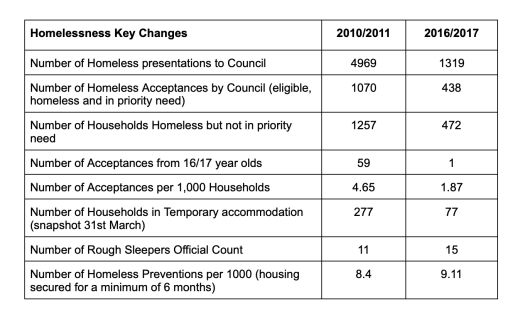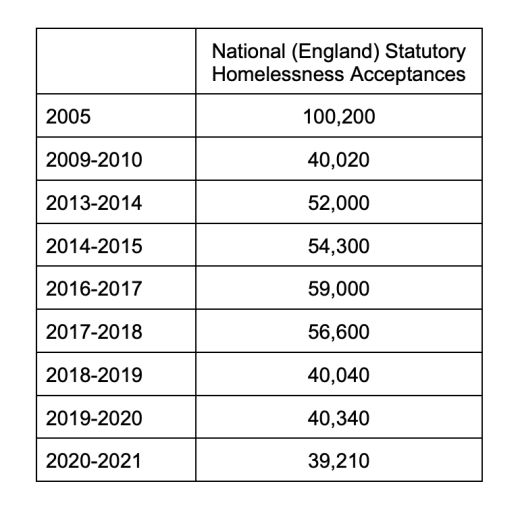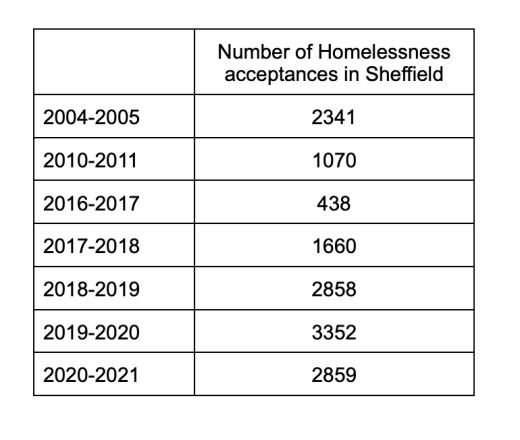This article explores how levels of homelessness have changed in Sheffield since 2005.
Author: Jessica Valins
Jessica Valins wrote this article for us as an intern at Citizen Network Research. In trying to understand the state of homelessness in Sheffield she discovered some important facts, but also some mysteries. Not only do we not quite understand why and how the problems in Sheffield have suddenly got much worse we also realise that the current systems do not help citizens understand problems, contribute to their solution or hold key institutions to account.
Homelessness does not just mean people sleeping rough. The term refers to those who are statutorily homeless - who lack a secure place to live. This can be caused by a number of reasons that include family and friends no longer being able to accommodate them, escaping domestic abuse or by being unable to pay the rent. This report focuses on those who have had their status on homelessness accepted by the council.
Those who are homeless are more likely to have mental health issues, long term physical health issues and use drugs. Once someone experiences homelessness, it can be incredibly difficult for them to get back onto their feet and find employment. It is estimated that 77% of those who experience homelessness, could sleep rough. Not only does homelessness have long-term psychological effects on those who experience it, but it also impacts the taxpayer.
It is estimated that the annual cost of homelessness is £1 billion and the average homeless person costs the country £26,000. [Homelessness, 2011] This shows that ending homelessness is in the interest of both the country and the individual. This report focuses on homelessness in the Sheffield region and it will explore how the problem has changed since 2005.
According to reports done by Sheffield City Council between 2005-2017, homelessness steadily decreased in the region during this period. The acceptance of homelessness refers to the number of people who applied to the council as being homeless and had their application accepted.
• The report stated that homelessness peaked in 2004-05, with acceptances at 2,341.
• In the year 2010-11, there were 1,070 accepted homelessness presentations.
• The council accepted 438 homeless presentations in the year 2016-17.
This shows that according to council reports, homelessness had steadily decreased since 2005. Between 2010 and 2016, homelessness in Sheffield decreased by 60%, compared to the national increase of 30% (see Table 1).

Table.1 Homelessness in Sheffield in 2011 and 2017
The statistics after 2017 suddenly present a very different picture.
• April 2017 - March 2018 - There were 1,660 cases where homeless prevention or relief duty was received, meaning the council was required to help relieve their homelessness, most likely through providing them with temporary accommodation. There was no record of the total applicants..
• April 2018 - March 2019 - Out of the 3,029 households who were assessed for statutory homelessness, 2,858 were assessed as being owed a prevention or relief duty.
• April 2019 - March 2020- Of the 3,518 households that were assessed, 3,352 were assessed as being owed a prevention or relief duty,
• April 2020 - March 2021 - 2,918 households were assessed for statutory homelessness. 2,859 of these households were assessed as owed a duty.
The majority of those assessed as homeless were single men between the ages of 25-34.
These two tables show the very different patterns between the national average and Sheffield (Tables 2 & Table 3):

Table.2 National Average - England

Table.3 Homeless in Sheffield
The fall in homelessness between 2004 and 2010 can be explained by the introduction of The Homelessness Act (2002) which focused on homelessness prevention and meant more people could access advice and assistance about their situation (Crisis, 2018).
The dramatic fall in homelessness cases in Sheffield between 2010 and 2016, as presented in the table above, seems surprising as the number of homelessness cases continued to increase on a national scale until 2017 and this would have been the result of the 2008 Financial Crisis and the austerity measures which followed. The national statistics on homelessness acceptances, reveals that homelessness began to increase from 2010, while in Sheffield, it did not increase until 2017.
According to this council report, the reason Sheffield’s homeless cases fell between 2010-2017 was a result of the strong measures which were put in place by the council which meant the majority of people were able to find long term housing solutions (Homelessness Prevention Strategy, 2017).
According to research done by the charity Roundabout, young adults experiencing homelessness, reached a five year high during Christmas 2021. This could be down to the end of the Government's furlough scheme, rise of living costs and reduction in the Universal Credit payments (Roundabout, 2021).
This reveals that while homelessness in Sheffield seemed to gradually fall leading up to 2016, following 2017, the number of cases dramatically increased. This is most likely due to the impact of the further austerity measures following the election of the Conservative majority government in 2015. However, austerity actually began in 2009/10, so it would have been expected that cases increased from this point, in line with the national cases of homelessness.
The cases in Sheffield continued to rise leading up to 2020 and then slightly decreased. The decrease in the year 2020- 2021 is most likely due to the government providing financial support during lockdown. They provided hotel rooms to those sleeping rough during this period. However, while the government has not yet released the data from 2021-2022, according to the local charity Roundabout, the problem worsened, following the end of the government's financial aid which was provided during the pandemic. Therefore, it is imperative that the government or local authorities continue to provide increased support for homeless people to ensure the issue does not get worse.
Notably, the data from 2005- 2017 comes from a different source to the data recorded 2017-2021. This could affect the statistics as the council may have measured homelessness differently to the government. In general the Council and Government may prefer to portray the issue to be less problematic than it is in order to make themselves seem more capable, while a charity may be more likely to exaggerate the problem to attract more funding.
Whatever the exact size of the problem it is clear that homelessness is still a major issue in Sheffield and a long term solution needs to be made in order to reduce the problem.
We have tried to find out more about the reasons why Sheffield seemed to do much better than the national trend for some years, and what has changed that Sheffield’s figures are now worsening.
If you can help provide more information please do let us know. Please contact hello@citizen-network.org
Everybody In (2018) Chapter 2: Public Policy and Homelessness in The Plan To End Homelessness. London: Crisis. Available from: https://www.crisis.org.uk/ending-homelessness/the-plan-to-end-homelessness-full-version/background/chapter-2-public-policy-and-homelessness/ [Accessed 25/01/22]
Detailed Local Authority Level Tables: Financial Year 2017-2018
Detailed Local Authority Level Tables: Financial Year 2018-2019
Detailed Local Authority Level Tables: Financial Year 2019- 2020
Detailed Local Authority Level Tables: Financial Year 2020- 2021
Impact of Homelessness (2011) Sheffield: Homeless. Available from: https://www.homeless.org.uk/facts/understanding-homelessness/impact-of-homelessness [Accessed 25/01/22]
Statutory Homelessness Annual Report 2020- 2021 (2021) Ministry of Housing, Communities and Local Government.
More Young People than Ever face Homelessness this Christmas (2021) Sheffield: Roundabout. Available from: https://www.roundabouthomeless.org/news/young-people-ever-face-homelessness-christmas/ [Accessed 24/01/22]
Sheffield Homelessness Prevention Strategy 2010-2013 (2010) Sheffield City Council. Available from: https://democracy.sheffield.gov.uk/ [Accessed 25/01/22]
Sheffield Homelessness Prevention Strategy 2017-2022 (2017) Sheffield City Council. Available from https://democracy.sheffield.gov.uk/ [Accessed 25/01/22]
The publisher is Citizen Network Research. Homelessness in Sheffield since 2005 © Jessica Valins 2022.
housing, social justice, England, Article